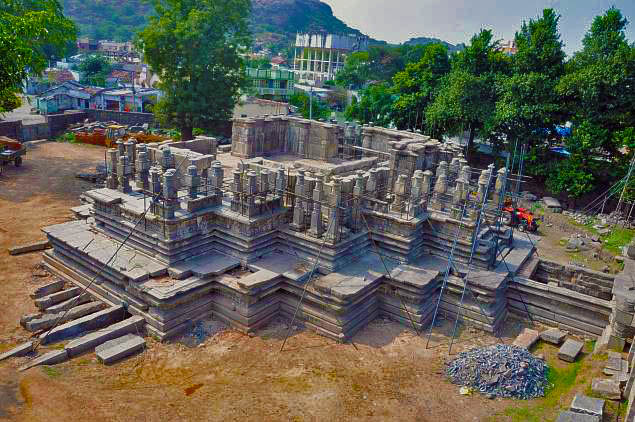Constructed in the 1163 AD by King Rudra Deva, Thousand Pillar Temple is one of the finest specimens of Kakatiya architecture and sculpture. The temple has three shrines, which are dedicated to Lord Shiva, Vishnu and Surya. This temple is also known as Rudreswarar temple and it took 72 years to construct the temple.
Kakatiya dynasty ruled Andhra region from 750 AD – 1325 AD – for 575 years, still lives in the ruins of the fort and almost intact temple.
The architecturally brilliant temple was designed by the sculptors from the Kakatian dynasty and it depicts the typical Chalukyan style of architecture. The entire temple resembles the shape of a star and the pillars have intricate carvings of artwork on them. In addition to the pillars, the walls of the temple too have fine designs on them which still makes many an artist go spellbound at the quality of workmanship that existed during those days, when technology was not even born.

A Still from movie Rudramdevi (2015)
Of the three shrines, Shiva’s shrine has been positioned facing the east while other shrines face south and west. This was so, because the Kakatiyas were great devotees of Lord Shiva and wanted early morning sun rays to fall directly on Shiva Lingam.
As in the case of any Shiva temple, there is a huge Nandi situated at the entrance of the Shiva shrine. The colossal structure of Nandi is carved out of a single piece of black basalt. A 5 feet high idol of Lord Ganesha is located on the left-hand side of the Sanctum Sanctorum.
Thousand Pillar Temple, with its own unique architectural style, is indeed the pride of India. The temple complex has lush green gardens, which attract everyone with their serenity.

The restoration work on the kalyana mandapam of ancient Thousand Pillar temple is nearing completion
The Thousand pillar temple was destroyed by Tughlaq dynasty, a Muslim dynasty of Turkic origin, during their invasion of South India. Until few years ago, it was in bad shape with fallen columns, roof and broken statues and abandoned.
The responsibility of renovating the temple was taken up by the Government of India in the year 2004. When the archaeologists removed the pillars, they found huge masses of wet land underneath due to the water resource nearby. It took nearly two weeks for them to take away all the sand.
There were 1,000 pillars in the structures, but no pillar obstructs a person in any point of the temple to see the god in the other temple.
The crumbling Kalyana Mandapam opposite the main sanctum sanctorum was dismantled for reconstruction in 2005. Though 10 years have gone by, it has not been built. According to sources, officials are planning to expedite the works at least by October this year as the government is planning Kakatiya Festival in October or November.





Thank you for your unique materials provided to any interested readers/viewers for the many wonderful ancient
marvels of India. I sincerely hope that the world at large can one day understand these marvelous wonders which have been conceptualized by greatly inspired intelligence and which the rest of the world can only admire